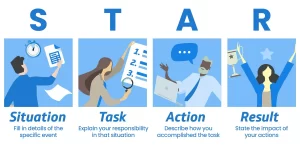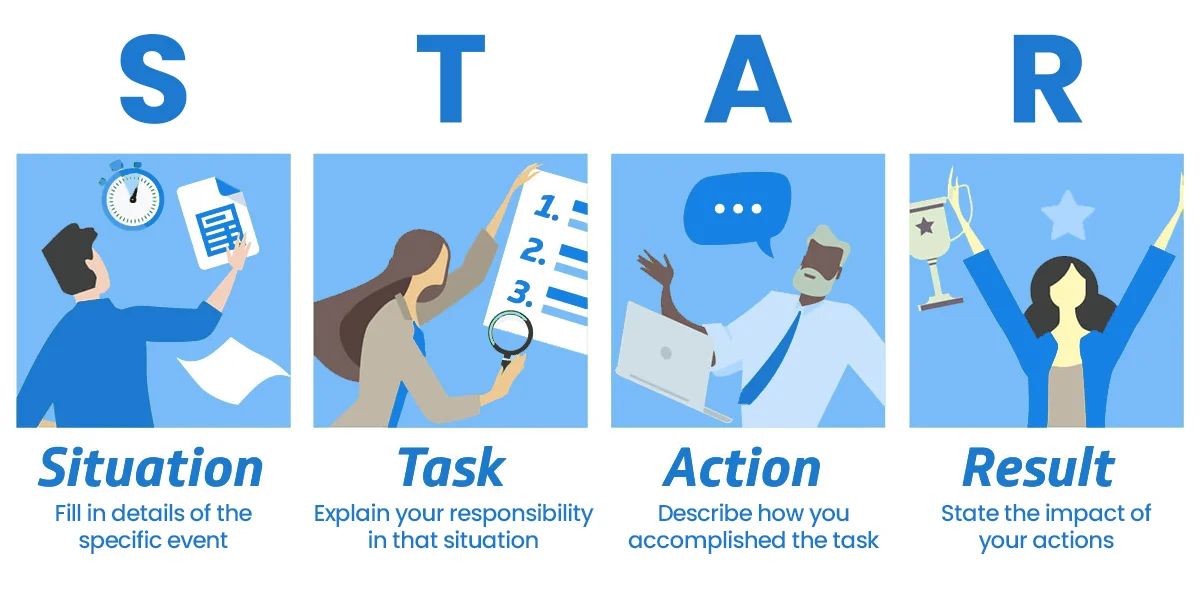By now, you may be aware that recruitment agencies, government entities, and corporate organizations widely employ the STAR method of interviewing. It is highly likely that you have encountered an interview heavily based on this model.
After the initial excitement subsides (if any), you can take a moment to reflect on the outcome, especially if you did not succeed, and come to the conclusion that it was a less than favorable experience. In this regard, you would be correct. The STAR model of interview was not intended to be the sole technique employed in an interview; rather, it serves as a complementary tool alongside other activities that should be part of the interview process.

‘ve just completed an interview (last week, at time of writing) where there were two managers and I. One would ask a STAR question, the other would write. Then the second manager would ask a STAR question, the other would write. This followed for a planned 45 minutes which ended up over an hour. What kind of questions might they ask? All over the landscape. Like, tell us about a time when you had to protect the rights of others. Tell us about a time when you had to handle stress.
What do you do? Well, there’s a natural way to answer and then theres STAR. I will explain STAR in a moment (although it’s allllll over the internet) but I would like to draw Manager’s attention to a few points we can’t say for the risk of loosing that precious job.
Firstly, when considering older candidates like myself, it’s natural for us to draw upon a wealth of life experiences rather than focusing solely on job-specific examples. After all, were you specifically requesting answers pertaining only to the job or also general experiences? With years of experience, older individuals often possess a vast array of impactful experiences and achievements outside of the workplace. During the interview, I shared some of these personal experiences that were genuinely empowering and life-changing.
However, I understand that this may not align with the expectations of the interviewers. I realize you may be thinking that even if someone has accomplished extraordinary feats, if they fail to address the job-related aspects, it would be considered a misstep.
To Managers: When utilizing the STAR model, it’s essential to communicate to candidates that you specifically seek responses that align with the job requirements. This clarification is particularly important when dealing with older applicants (typically 40 years old and above) who tend to draw on their broader life experiences.
For Everyone Else: It’s crucial to understand that interviewers using the STAR method are primarily interested in hearing feedback that follows the STAR framework and directly relates to the job at hand. For instance, if you are applying for a mechanic’s role, they won’t be particularly interested in hearing about your accomplishments in safeguarding privacy rights back in 1984. Similarly, your brave transition to the field of Information Technology during the emergence of personal computers may not be directly relevant. Instead, they want to hear about your experiences and activities that specifically demonstrate your capabilities in relation to the job requirements.

When in Rome, speak as the Romans do. Got it? It’s easy. Just remember the simple point I just made. Repeat after me: IF IN ROME, TALK ROMAN.
Now, the second important aspect to understand about Romans and their answers is simplicity. Keep it simple. It’s best to limit your STAR response to a few sentences for each part.
So, we have two key concepts: IF IN ROME, TALK ROMAN, and Romans don’t tend to be verbose.
That’s valuable information.
Now, let’s delve into STAR. What is it, and why should you both love and hate this darn thing?

S ituation
T ask
A ctivity
R esult
Situation – describe a situation. For instance, in the Mechanic role, they might ask you how you handled stress. Keep it simple. A few sentences at best. In the 1980’s I was working at Jo’s Garage and they were forever double booking vehicle warrants and repairs on top of drive in work.
Task – I was tasked with the job of seeing how I could eliminate booking errors like the double ups.
Activity – I researched the newest tools on the market which at that time just happened to be the introduction of Personal Computers. I evaluated several models and software applications and made a report covering a variety of choices for management to consider.
Result – Management installed a new system in the next three months which reduced booking errors, but we had further work to do to accomodate drive in work.
Great stuff. Easy to follow. Honest. Short and to the topic. See?
Now, if I had of mentioned how I saved the privacy rights of hundreds of people when a volunteer in a government group, you’d probably go, interesting, but what’s that to do with the job? Hindsight is just bleh, isn’t it?
So we can add, KEEP TO THE TOPIC, to the short list of techniques.
Notice how Task and Activity are similar but not quite the same? The task means, to explain what is intended. The Activity is what you actually undertook. The actual activity.
How to ACE the STAR interview.
First though, I want to tell you about a person who was so adult ADHD, they absolutely could not work with the STAR model. At the interview, when the managers were explaining they intended to use the STAR technique, the applicant was honest and explained that process does not work for them. So they used other methods of Q&A. The applicant got the job.
Here are some common words managers use in the STAR model. Although they can use any question or word they like (so be prepared for this.) Give me examples of how you managed:-
Being flexible; Stress; Angry customer; teamwork; decision making.
Ok, so the above was general. Here are a few actual questions if this helps understand how you might be asked:
- “What’s the hardest decision you’ve had to take at work?”
- “How do you handle stress”.
- “Give me an example of when you’ve motivated others.”
- “Give me an example of how you’ve worked as part of a team.
Remember these rules, especially us oldies:
- When in Rome, talk Roman.
- Roman’s like to keep it short (on point.)
- Relate specifically to the job, agency, corporate etc.
To support the STAR interview response process, here are some enhanced ideas:
- Conduct thorough research: Take the time to research and gather information about the agency, business, and working conditions relevant to the vacancy. Gain an understanding of the government department’s activities, operational procedures, and potential experiences related to the role, such as stresses, activities, and responsibilities.
- Create STAR response sheets: For each of the ten activities or observations you researched, create a separate STAR response sheet. Provide a clear heading or title for each activity, followed by a concise description of the situation, task, action, and result. Save each sheet as a document on your computer, review them, practice saying them out loud, and refine them until they are well-crafted and polished.
- Establish an “activity wall” or board: Write out the ten activity headings and pin them up on a designated wall or board. This will serve as a visual reminder and prompt for you to review and internalize your STAR responses. Prior to the interview, read them daily, make improvements if needed, and gradually make them your own. Consider placing them around your monitor or workspace for easy reference and reinforcement.
- Utilize the activity wall during online interviews: If you have an online interview, position yourself near the activity wall or board. This will allow you to discreetly glance at the subject headings as gentle reminders without diverting your eyes too much. Remember, maintain eye contact with the interviewer, as you will be closely observed.
- Write down the question: When the interviewer presents a question, it’s beneficial to write it down. This practice helps prevent the possibility of forgetting the question while passionately presenting your STAR response. Writing it down serves as a reference point to ensure your answer remains aligned with the specific question asked.
- Emphasize the importance of writing things down: In addition to writing down the questions, it is crucial to emphasize the value of writing down key points, ideas, or any relevant information throughout your interview preparation. This aids in organizing your thoughts, maintaining focus, and ensuring you cover all the essential details.
By implementing these strategies, you can enhance your preparation and delivery of STAR responses, increasing your confidence and ability to effectively address interview questions.
A few final points from your STAR based interviews:
- Maintain a positive and confident attitude: Approach the STAR questions with confidence and positivity. Showcase your abilities and experiences with enthusiasm, demonstrating your capability to handle challenges and achieve results.
- Seek feedback and learn from it: After the interview, if you receive feedback on your STAR responses or overall performance, take it constructively. Use the feedback to improve your interview skills and refine your STAR stories for future opportunities.
Feedback and additional notes that support others (we could include) always welcome.
Kevin.



